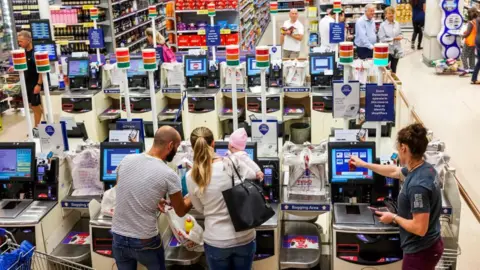In recent days, Tesco’s introduction of advanced artificial intelligence technology at some self-checkout counters has sparked a wave of humor and criticism among its customers. Shoppers have humorously likened the overhead cameras resembling VAR (Video Assistant Referee) systems used in football. This innovative technology aims to curb increasing instances of shoplifting by monitoring checkout activities and documenting when an item fails to be scanned.
The cameras are positioned above the self-service checkouts and are designed to display a live-action replay of items that weren’t scanned correctly. However, reactions from patrons have been mixed, with some poking fun at the approach while others express serious concerns about the measures being overreaching. Several customers have declared a reluctance to utilize self-checkouts again, fearing an intrusive surveillance experience.
This strategic move by Tesco aligns with the troubling statistics surrounding theft in the UK, which recorded a staggering spike in shoplifting incidents in 2024. According to the Office for National Statistics, police recorded shoplifting offenses in England and Wales rose by 20%, amounting to 516,971 cases. However, the British Retail Consortium reports that retailers themselves documented even higher figures, with 20.4 million thefts attributed to this crime during the year leading to last September, totaling an alarming loss of £2 billion for retailers across the nation.
To combat these rising thefts, Tesco’s implementation of this technology is notably aimed at assisting consumers in identifying scanned items that might have been missed. If a customer’s item does not successfully scan, the self-service screen displays a message, indicating, “The last item wasn’t scanned properly. Remove from bagging area and try again.” The supermarket believes that this will streamline the checkout process, making it relatively swifter and user-friendly.
In a similar vein to Tesco’s approach, Sainsbury’s has also deployed AI recognition technology at some self-service stations. A spokesperson from Sainsbury’s emphasized the importance of security measures, explaining that their decisions regarding implementations are influenced by several factors, notably the desire for a smooth shopping experience for customers.
The playful reactions from shoppers have surfaced on social media platforms, with comments such as “VAR Decision – Tuna Disallowed,” capturing not only the humorous aspect but also the growing consensus that such technological advancements may inadvertently lead to an increased surveillance presence in stores. One concerned comment on Bluesky posited, “What’s next? Drones to follow you about the store?” highlighting fears over personal privacy.
The spotlight on evolving security measures brings attention to Tesco’s past initiatives, such as giant trolley scales implemented at their Gateshead location, which similarly received divided opinions from customer feedback. In an effort to address the pervasive issue of theft, other retailers like Greggs have opted to handle high-risk items behind counters, further indicating a trend among retailers to manage losses by adjusting their service formats.
Recent developments in store security have often found supermarkets implementing protective measures such as security tags on products, alongside increasingly frequent adaptations to the self-service experience. The changing landscape of retail, challenged by unprecedented shoplifting figures and shifting customer expectations, has led to these technological responses. While they may offer solutions to theft, they also prompt discussions about convenience, customer experience, and the extent of acceptable surveillance in the shopping environment.
In light of the ongoing challenges facing retailers, these technological strategies signify a critical step in adapting to modern theft patterns, although they do not come without the costs of potential discomfort for customers navigating an ever-demanding retail landscape. Thus, as this situation unfolds, Tesco’s AI surveillance initiative might become a bellwether for how other retailers innovate and respond to the dual necessity of enhancing customer experience while maintaining robust security measures.



